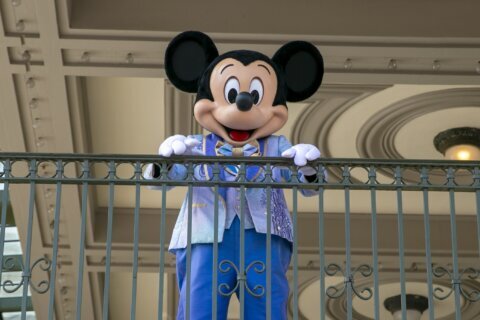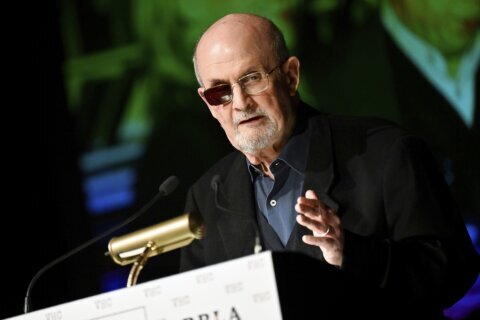WASHINGTON — It’s the National Archives’ most requested photograph.
On December 21, 1970, White House flashbulbs captured a handshake between two unlikely figures, the King of Rock n Roll, Elvis Presley, and the leader of the free world, President Richard Nixon.
Turns out, the meeting occurred a year before Nixon began recording his Oval Office conversations on his infamous Watergate tape recorder, so it’s anyone’s guess as to their actual conversation.
But director Liza Johnson imagines what that historic meeting must have been like in the new movie comedy “Elvis & Nixon” (2016), now playing at select theatres in our area, including Landmark E Street Cinema, AMC Shirlington 7, Landmark Bethesda Row and the Angelika Film Center Mosaic.
“[It’s] this real comedy of situation,” Johnson told WTOP via Skype. “It simply is absurd when the coolest person on the planet goes to meet possibly the least cool president that we’ve ever had.”
In a bizarre request, Elvis (Michael Shannon) asks longtime friend Jerry Schilling (Alexander Pettyfer) and assistant Sonny West (Johnny Knoxville) to arrange a meeting with President Nixon (Kevin Spacey) in the hopes that the federal government will make him an undercover narc. Yes, really.
At first, the busy president scoffs at the idea — as does Chief of Staff H. R. Haldeman (Tate Donovan) — but Nixon aides Egil “Bud” Krogh (Colin Hanks) and Dwight Chapin (Evan Peters) eventually set up the meeting with the hope of celebrity autographs and potential street cred with the youth vote.
“It is one of the more surreal chapters of American history,” Johnson said. “Nixon doesn’t understand why he should meet a rock star. … In the present, the relationship between entertainment culture and political culture has become so profoundly [blurred] that, to me, it was just interesting … to think about this time when it could have … not been obvious to him why he should meet The King.”
Indeed, it’s easy to take for granted that there was a time when entertainment and politics didn’t mix. President Barack Obama recently welcomed the creator of Broadway’s “Hamilton” for a White House freestyle, while Republican presidential candidate Donald Trump used to host a reality show. It’s fascinating to watch a window in time when politicians and entertainers were still strangers.
This lack of understanding of each other’s jobs drives much of the comedy in “Elvis & Nixon,” particularly the fact that Elvis actually thinks Nixon will give him a badge to conduct federal sting operations at hippie communes. Can you imagine Elvis going undercover? Everyone knows his face.
Johnson exploits this irony by showing the awestruck reactions of strangers, namely his female fans, who gush over him like the gals singing “We Love You, Conrad” in “Bye Bye Birdie” (1963). The fawning is not only used for comedic effect, it’s used to set up a contrast with Nixon’s skeptical reaction. As the film progresses, we gradually watch Nixon thaw, as he warms up to Elvis’ odd charisma and comes to believe the two are kindred spirits in the war on drugs and communism.
This bromance carries the quirky comedy, providing juicy acting moments for Shannon and Spacey. Both coincidentally hail from the School of Sam Mendes, who directed Spacey to an Oscar win in “American Beauty” (1999) and Shannon to an Oscar nomination in “Revolutionary Road” (2008).
“It’s these two giants, these kind of most famous, most powerful white guys of that moment, so I felt that in order for that scene to work, it had to also feel like a kind of actorly clash of the titans.”
Indeed, when you first see Shannon in the role, you might question his physical likeness to The King. As a White House guard admits, “He’s taller than I expected.” But any initial skepticism fades as we settle into Shannon’s focused portrayal, presenting Elvis as a sort of unrealistic dreamer.
“Michael Shannon was attached to the project when it was presented to me,” Johnson said. “If you just took me in a vacuum and said, ‘Who should play Elvis in some movie,’ I probably wouldn’t have thought of him. But when I read the script, I was like, ‘Oh, I get it,’ because there’s … the kind of deep inner-life performance work that we know Michael to be capable of.”
As for Spacey, it’s fun watching him portray a different presidential figure than his Emmy-winning Frank Underwood in Netflix’s “House of Cards” (2013). This time, he adopts a receding hairline and gruff voice, while losing the southern drawl of Underwood’s signature South Carolina accent.
“He had auditioned for ‘Frost/Nixon,’ so he had already thought about the role. He didn’t get it, but he had thought about it,” Johnson said. “He said he got back out the screen test and he was able to study what he had done wrong. … He does obviously think a lot about what it means to embody state power … not just with Frank Underwood, but with Richard III and other characters that he’s played.”
Don’t expect to see Claire Underwood. The closest thing we get to Robin Wright is Tom Hanks’ son, Colin Hanks, who dazzles in a stellar supporting role as Nixon’s trusty aid. The young Hanks offers plenty of self-deprecating jokes about his Hollywood lineage, as Spacey tells Hanks the importance of not having everything handed to you just because you’re born into wealth and privilege. Wink wink.
Even more meta — but delicious for “Forrest Gump” fans — is the appearance of a Dr. Pepper bottle on the Oval Office coffee table. You’ll remember Tom Hanks gulping down 15 Dr. Peppers before telling JFK his bladder was full. Let’s also remember that it was Gump who taught Elvis to shake his hips and who caught Nixon by reporting flashlights “looking for a fuse box” at the Watergate Hotel.
Still, the younger Hanks is a talented force in his own right, having earned a Golden Globe nomination for his role in TV’s “Fargo.” He also knows his way around a fictional Oval Office, having played the speechwriter in Oliver Stone’s “W.” (2008). In “Elvis & Nixon,” he’s eternally amusing as he bites his lip and grits his teeth, trying to play it cool at each oddball request by Elvis in front of the president.
It’s almost as if the screenplay has a comedic actor’s touch — oh wait, it literally does. That’s because screenwriters Joey & Hanala Sagal co-wrote the script with actor Cary Elwes, the hilarious star of Mel Brooks’ “Robin Hood: Men in Tights” (1993) and Rob Reiner’s “The Princess Bride” (1987).
“I was on set [and] went up to this guy and it was actually Bud Krogh, the actual guy from the Nixon administration,” Johnson said. “He was like, ‘Who wrote [the script]?” … I said, … ‘Cary Elwes.’ … He looked at me and started doing scenes from ‘The Princess Bride!’ The next day … he did those same scenes for Cary Elwes. Then shortly after that, we all went to a bar and Johnny Knoxville lit Alexander Pettyfer’s foot on fire with tequila, and I just thought this is the most surreal week of my life.”
But don’t let Johnson’s humble humor fool you. Beneath the laughter, she’s a darn good director.
Her short films “In the Air” (2009) and “Karrabing! Low Tide Turning” (2012) earned a pair of Golden Berlin Bear nominations at the Berlin Film Festival, while her feature film “Return” (2011) — which also starred Michael Shannon — earned a Golden Camera nomination at the Cannes Film Festival.
In “Elvis & Nixon,” Johnson delivers some impressive, yet subtle directorial touches. At one point, the soundtrack lyrics say, “Push and pull” just as a character pulls a door shut. At another point, she uses a symbolic mirror reflection as Elvis discusses his still-born twin brother. All along the way, Johnson maintains a ’70s period look and tone reminiscent of David O. Russell’s “American Hustle” (2013).
“There’s no right way to shoot a scene in general, there’s only a way to support the story that’s on the page,” Johnson said. “On this, I really liked working with the cinematographer Terry Stacey, and together we developed a lighting strategy that we thought was bright enough to support the comedy, but also has enough shadow and depth to support the depth of character that is also there.”
We can gather something about her comedic sensibilities by the film on the TV screen when we first see Elvis at Graceland. He’s watching “Dr. Strangelove” (1964) and laughing at the famous line, “Gentlemen, you can’t fight in here. This is the war room.” Although, Kubrick isn’t her model here.
“This is aspirational, but I like to think about people like Mike Nichols, who made so many movies that are funny, but not at the expense of the characters that are depicted,” Johnson said.
The Nichols film that “Elvis & Nixon” most resembles is the historical comedy-drama of “Charlie Wilson’s War” (2007). In the end, “Elvis & Nixon” isn’t quite as profound as that film — after all, it explored CIA-funding of the mujaheddin in Afghanistan, which backfired with 9/11 — but it’s still an entertaining look at two of America’s most famous figures on a glorious day in the Oval Office.
“Beautiful, isn’t it, Mr. Presley?” Nixon asks, pointing to the White House interior.
“Yeah, looks a little like my place,” Elvis replies.
Who knew Graceland and the White House had so much in common?

This rating is based on a 4-star scale. See where it ranks in Jason’s Fraley Film Guide. Follow WTOP Film Critic Jason Fraley on Twitter @JFrayWTOP.








